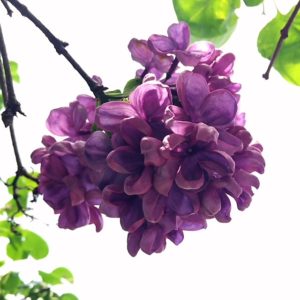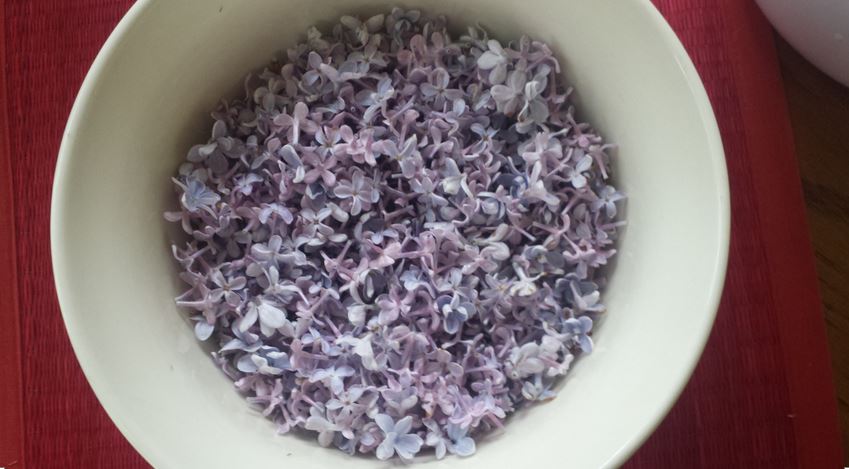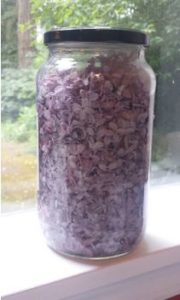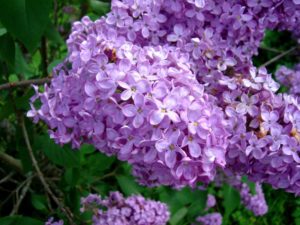
I have always associated lilacs with grandmas. Not necessarily my grandma. She used to ride shotgun (possibly literally) with a bootlegger, was a “Rosie the Riveter” during WWII, and tried cross-country skiing for the first time at the age of 77. But maybe her mother, my great-grandma Annabelle Greathouse. (Isn’t that a wonderful name?) I remember her pastel-colored dresses, her impossible-to-replicate macaroni and cheese, and her flower garden. She always smelled powdery and cool, even in the hot and humid Florida sun. She reminds me of lilacs.
Our home is surrounded by tall lilacs at the entrance and by our kitchen. My husband is sensitive to the smell of lilacs, so I had resigned myself to never being able to enjoy cut flowers in the house. But then I learned that you can eat the flowers. (Ooh – maybe I could sneak some lilacs in the house that way….) There are all kinds of recipes for the flowers: cordial, wine, candied, jelly, honey, cake, frosting. You can even just add a few flowers to water for a fragrant refresher.
I made lilac cordial for the first time last year. In the past, I have made plum, raspberry, pear, hazelnut, and even coffee (mmmmm) cordial. The recipe below is so simple: fruit/herb, vodka or brandy, and simple syrup (sugar water). I used lilacs from our yard which are light lavender, pinkish, and almost white with a faint dark purple hue on the edges. The best flowers to use are the ones that are most fragrant. I also prefer darker flowers – not necessarily because of their scent, but for the beautiful purple color imparted to the cordial.
Lilacs appear to be delicate, but the individual flowers that make up the cone are quite firm and hardy. That ability to maintain their shape makes them excellent for candy-coating with sugar. They are also a breeze to quickly rinse off and whip-dry in a salad spinner without reducing them to shreds. The hardest part about making lilac cordial is removing the bitter green part from the base of the flower stems. You can try to snip off the flowers, but the best way is to pull them off one by one. You can be a little impatient and pull off several at a time. But if you’re a fanatic about removing all traces of bitterness, you’re going to go back and ferret out the little green parts of the stem that came off with the flowers. Hypothetically speaking, of course.

Tips for making lilac cordial:
- Choose fragrant blossoms, preferably dark purple in color.
- As always, choose blossoms free from pesticides or pollutants.
- To ethically harvest, don’t use more than 1/3 of the flowers on a lilac plant.
- Shake the blooms to remove little critters. You can quickly rinse the flowers, but that might remove some of the fragrance.
- Ensure you give yourself a LOT of time to separate the flowers from the green part of the stem. It took me 45 minutes to pick enough flowers to fill a one-quart jar!
- The flowers turn color fairly quickly after they have been removed from the stem, so make sure you have enough vodka to cover them or else the exposed ones will turn brown.
Lilac Cordial Recipe (such as it is)
Ingredients:
Enough lilac flowers to fill your container (about 6-7 flower cones for a one quart jar), green parts removed to the best of your ability/temperament
Vodka to fill container
Simple syrup to add after infusing (recipe below)
1. After processing the flowers, fill your container with the lilacs.
2. Add enough vodka to cover the flowers completely and fill to the bottom ring of the top of the jar.
3. Tighten lid and keep jar in a cool, dark area for about six weeks. Occasionally shake the jar and top off with vodka if more is needed to keep the flowers covered.
4. After six weeks, strain out the flowers. I usually do this over a large measuring cup with a strainer that fits over the top. Make sure to mash the flowers with a wooden spoon so you can get every good-to-the-last drop.
5. Prepare the simple syrup, then slowly pour in a steady stream into the cordial, stirring constantly. Start with 1/4 cup, then add more to taste. (It’s OK to add the entire cup if you like a sweet cordial!)
To make simple syrup:
- Fill a medium-size pot with one cup of water and bring to a gentle boil.
- Slowly stir in one cup of sugar and mix until dissolved.
- Allow to cool. Store in refrigerator for several days if not using right away.
6. Enjoy! Cordials can keep for years and can taste better and better with time. I have a pear cordial from eight years ago that is one of the most sublime beverages I have ever tasted. Try the ultimate slow food and make (or save) enough to sample a “vintage” cordial.
Some recipes only call for a two-week sitting time. I’ve found that the flavors meld better and are more complex if you allow the flowers/herbs to infuse the full six weeks. If you don’t have the time (or patience) for cordial, try adding a few flowers to your drinking water. Like their scent, the lilacs have a perfume-y taste that easily permeates the water with the unique flavor of springtime.

